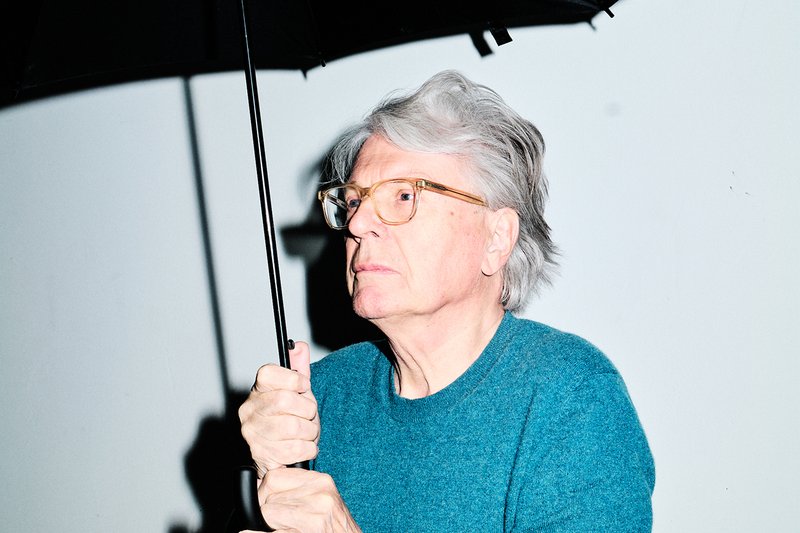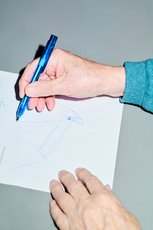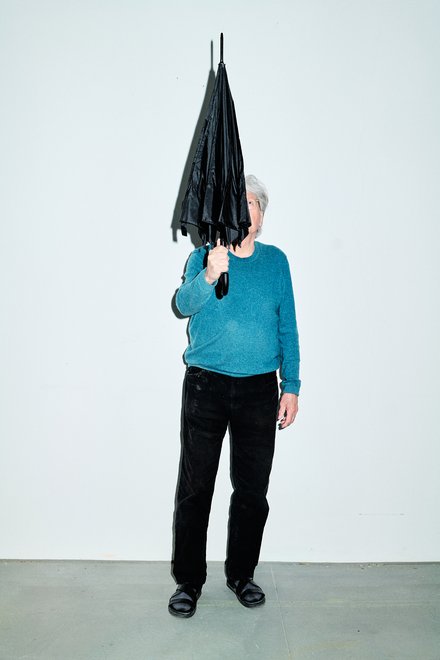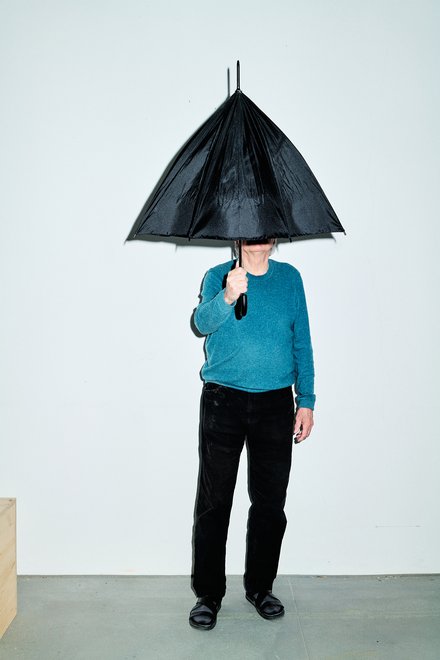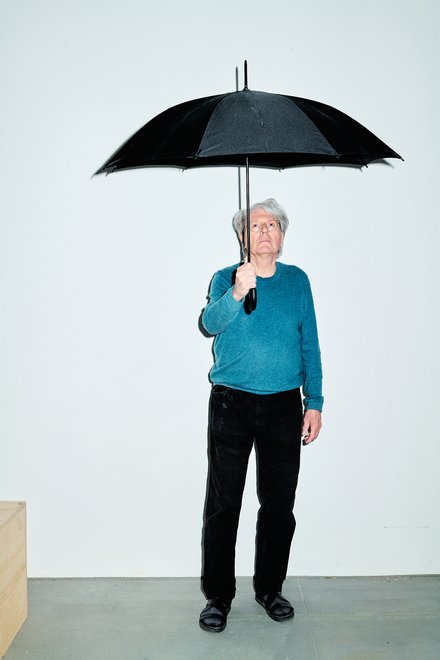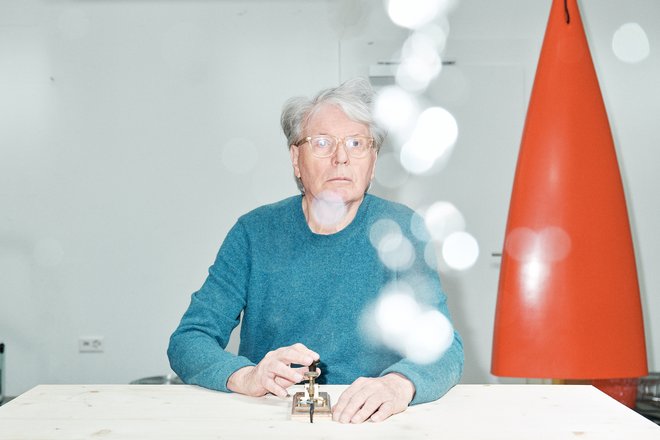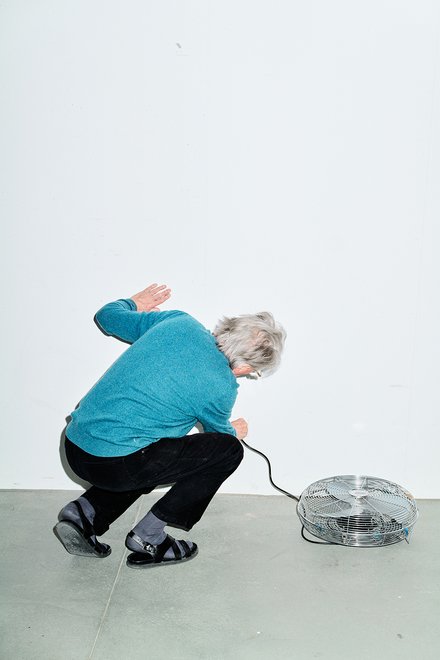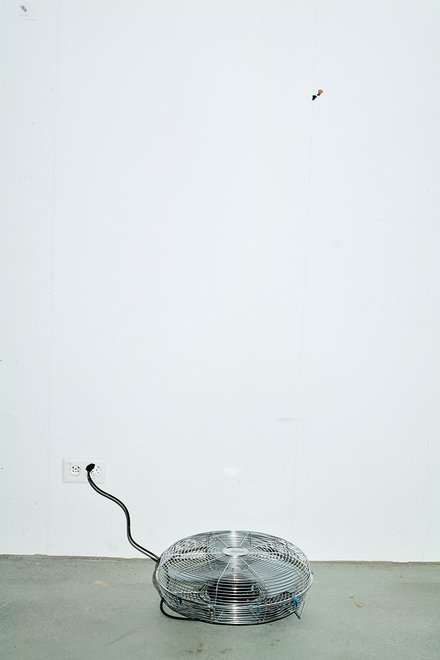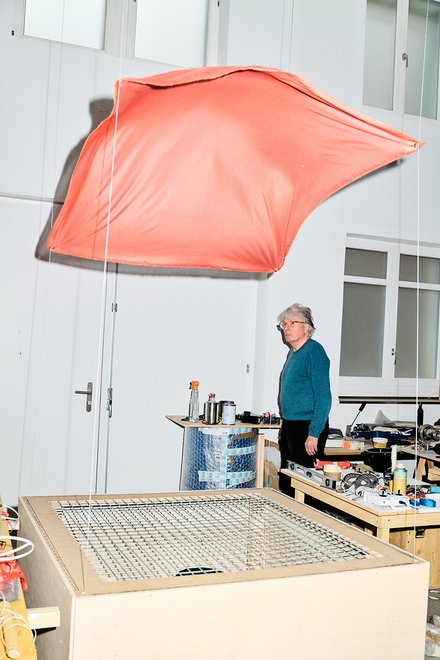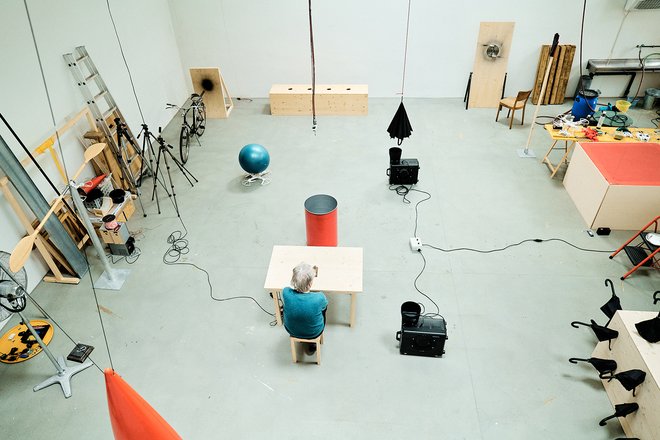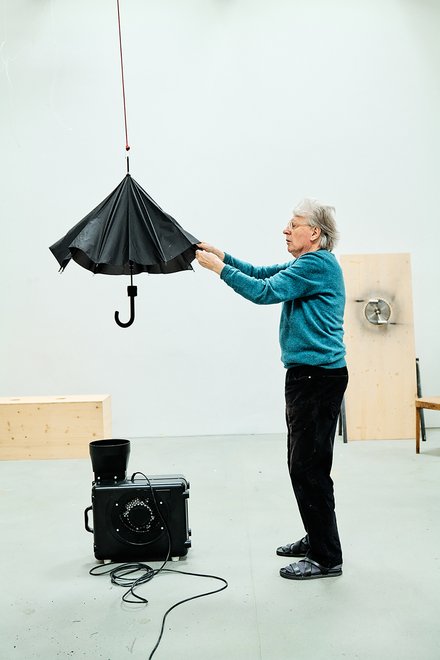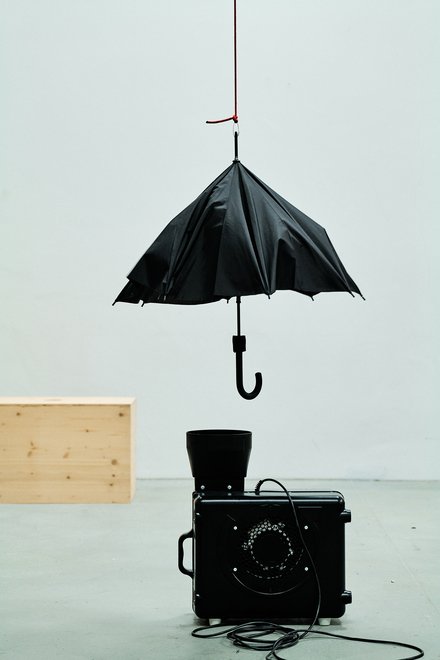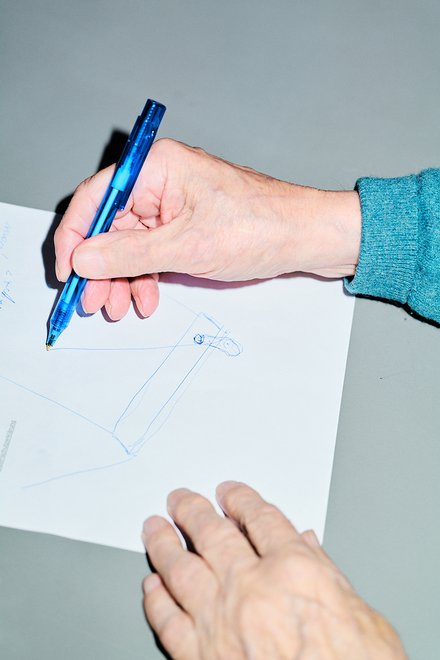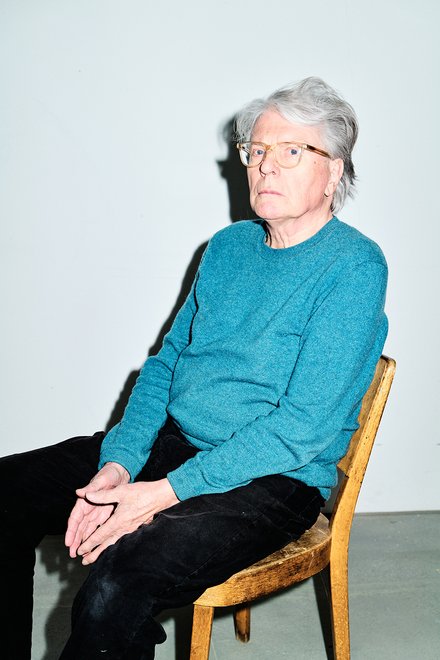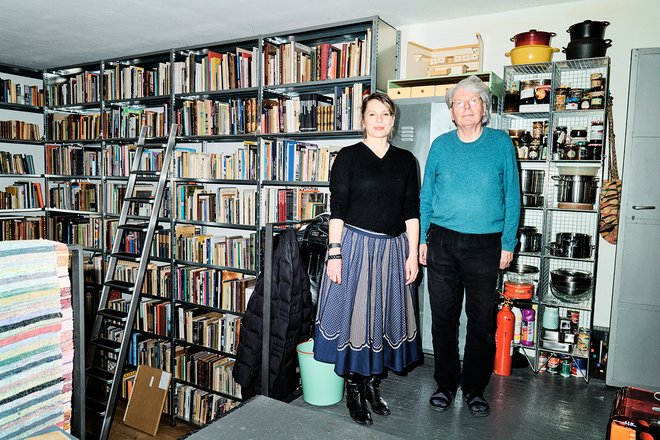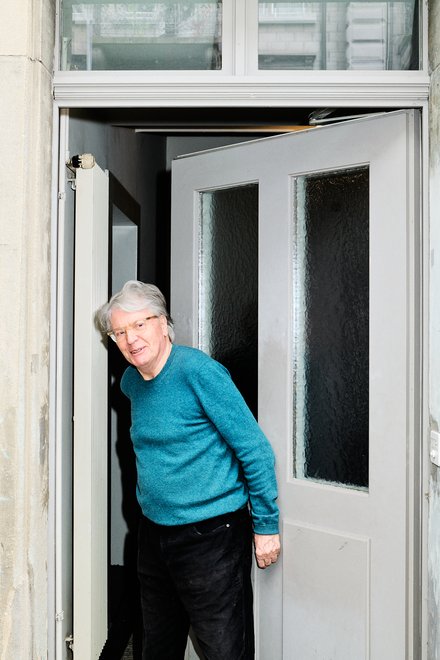Jump out of a plane with an umbrella in my hand.
The Swiss Roman Signer (*1938) is one of the most enigmatic European artists of the present day. His works are processual sculptures with a bizarre aesthetic, full of poetry and humor, the result of meticulous planning and unpredictable coincidence. Signer and his wife Aleksandra welcomed us in their studio in St. Gallen. We spoke about childhood, the joy of explosives, about shame and happiness.
“Very elementary processes.”
Did you pull a lot of shenanigans as a child?
Oh yeah, dangerous ones, too. My uncle owned a hardware store and sold explosives, they were freely available back then. I often got some from him. Today everything is heavily regulated.
In many interviews you mention that you prefer not to be reduced to the “explosive artist”, but don’t you still have a penchant for explosions and startling people?
I don’t want to scare anyone, sometimes I just scare myself. (Aleksandra Signer comments in the background: “He’s just being honest!”) People have the wrong image of me: “ Signer, the explosive artist”. I also work with water, sand, wind – you know, the elements. Of course, I have always enjoyed an explosion here and there, it’s relaxing. Afterwards, you feel totally light, as if you could float. Nowadays, I just do pyrotechnic stuff with rockets, gunpowder, and the like. The police “snatched” my gunpowder, they say I’m too big of a risk.
As an artist?
As an artist and terrorist (laughs). But I have always stuck to the rules and was never too suspicious. I have an explosives permit.
You once told of an occasion when you almost flipped out as a young boy at a celebration of a typical Swiss ritual with fire because you enjoyed yourself so much. What was that?
That was Spark Sunday (Funkensonntag) in Appenzell, where I grew up. Children collected flammable materials, boxes and old boards, and made huge cones out of them and set them on fire. Then a stupid public official had the idea to fill up a glass with ashes the next morning and send it to the environment agency in Bern.
“An explosion is relaxing.”
What was the result?
They analyzed it and wrote: “Stop immediately, it is full of chemicals and contaminated.” So that was the end of that. In Vorarlberg these days, they make towers out of wood; we have adopted the idea here in Switzerland. It’s also nice, but it is just not the same anymore. The thrill was the collecting, I always took part in that as a boy. The kids from the next village came to town with big carts and robbed us like pirates. Like on the high seas.
Switzerland can be quite narrow. And often you make fun of it indirectly in your work…
Paradoxically, however, you can also do a lot of things here in Switzerland, which you would not be allowed to do elsewhere. All the Swiss have weapons at home, I just have handguns. And naturally a shotgun, too! I’ve used them all in the context of my artistic work.
It’s great that you put weapons to a more constructive use. Here is a quote from Goethe’s Faust II: “The poet who perfects himself the more, he spends from his most precious store.” What does the idea of waste mean for you?
Waste is the opposite of pettiness. I’m not petty. Otherwise, I couldn’t do the things I do. My work is wasteful, and sometimes I am accused of being so. At documenta 8 in Kassel I did my explosion action Aktion vor der Orangerie [Action in front of the Orangerie] with thousands of sheets of paper, which I detonated and made rain down from the sky. Thereafter, a teacher – typical teacher – wrote to me that I should be ashamed for wasting so much paper.
Do we need to waste in order to survive?
I don’t know. For sure, what I do with material is a waste. There is no point in moralizing about it.
"An event is always big."
For me, waste is a positive word. My theory is that humans need orgies and sacrifices.
Waste is a must! If everyone would be too parsimonious, nothing new would come about. Art is a waste of energy, it is a waste of the life of the artist. One could say, as an artist, I could do something more valuable for humanity, some form of work…
…baking bread, for example…
…pouring concrete, fitting tires – practical stuff. But this is what I do. At the security check in Zurich Airport a police officer came to me and asked quite earnestly: “Are you Roman Signer?” I replied: “Yes.” Then he said: “Congratulations!” He really appreciated what I do. That was a nice experience.
Why do you think other people enjoy your work so much?
I’m not sure. It touches something in the soul, something which perhaps has to do with our childhood.
"I was always a bit ashamed."
In collaboration with the Kunsthaus Bregenz, you will realize a work on the Bielerhöhe at more than 2000 meters above sea level. Your intervention makes a mountain stream flow up over a bridge. Typical for your work: You invert the order of the elements!
I want to install a work on a stream, which will be realized by engineers from the Illwerke company. The stream flows down from a cavern on the Tyrolean side of the Bielerhöhe. I will dam a part of the stream and redirect it with a water hose. Then the water shoots out of a pipe in a high arch over the bridge that crosses the stream and lands directly in Silvretta Lake. In a sense, the jet of water becomes an architectural element and sculpture of sorts. I was interested in the pressure that accumulates due to the 60-meter height difference. Making the physical tangible is paramount for me, and less so the story that could perhaps be derived from it.
In an interview you said that you are occasionally ashamed when you initiate such “events” and would like to run away…
That’s how I feel on the inside. An action in front of an audience with an explosion, for instance, is something very special, when it feels like a thousand eyes are watching you. I’m much calmer when I make a film. Nothing can go wrong – woe, if something would happen to a visitor, then I’m a goner. I have always been extremely careful.
You are speaking about the aspect of danger, but obviously there is still something beyond that, namely the feeling of shame.
I still have to get used to it, I have always felt a bit ashamed when I stand like an exhibitionist in front of an audience. I was never a performance artist, I don’t do it out of vanity – these are very elementary processes.
"These are Sculptures. I'm just the trigger."
And perhaps the shame results from doing something so powerful like diverting the elements?
I want to be seen as the organizer of the event. I am just the trigger. And endure it. I’ve always said that these are sculptures, and the viewers see the transformation of a sculpture. Especially in Switzerland, people have dismissed my things as “spectacles”. In France this has a completely different meaning: a “spéctacle” is a performance in a theatre; it doesn’t have this negative connotation. Actually, I have stopped making actions. I make my works for myself and prefer to make videos of them together with my wife Aleksandra, who is also an artist.
Can you remember the first work you took public as an artist?
For one of my first works, I filled a wooden box with clay, jumped into it from a chair, and thereby created evidence of this act with my footprints. This work is called Selbstbildnis aus Gewicht und Fallhöhe [Self-Portrait with Weight and Height of Fall] and is from 1972. I have always called these actions events, small events. But then I was informed by a philosopher who said: “There are no small events, an event is always big.”
"The things I did as a kid still flow into my work today."
Generally speaking, what you do as an artist is also what children really love to do. They drop something and playfully test out how gravity works. Or they fervently divert water, create wind, and wreck things with a passion!
Children are sensitive, intelligent, and have a lot of fantasy. The things I did as a kid still flow into my work today. (Aleksandra Signer from the background: “He’s simply not corrupted by his surroundings. He is sincere!”) For me, art is a necessity. When you hit puberty they say: “Time to get out of those kid’s shoes!” But I could never make the change.
Your art touches people, but it is also quite humorous. Don’t you have to laugh about your events sometimes?
Not everything is funny, I also make sad things.
I have to laugh about the Bielerhöhe action, redirecting the stream over the bridge. That’s funny!
It’s not forbidden, thanks heavens, we can still laugh. I don’t know why you are laughing about it. For many hikers it is perhaps a small adventure to walk under the arch of water. Maybe they will have to surmount their fear of getting sprinkled with water.
“My work is waste.”
It is fun when things and elements do something else than they should. You shoot tables out of a house, redirect water, fans move objects. What’s up with the umbrellas you often use in your works?
An umbrella is like a sword or a rocket. Flying Robert in Slovenly Peter also has an umbrella. It always scared me as a child, how he flew away with his red umbrella, becoming smaller and smaller and suddenly vanished, all because he didn’t behave and stay indoors during the storm. The table is very archetypical. Every family has a table where they eat, drink, and talk together. In my eyes, a table resembles an animal – a cow has four legs, too.
What makes you afraid?
People. Nature less so. She is unpredictable and can also play tricks on you. I have respect for her. But in my actions I have no time to be afraid. There is always a certain tension that’s hard to bear. You never know if someone is going to walk around the corner at the last moment.
“Love and observe nature.”
How should we behave toward nature?
We need to be responsive to nature, find the right moment, and don’t just rashly do something with her: love and observe. And then, perhaps, she will leave you in peace. One must treat her like a living being and don’t do anything stupid.
What makes you happy?
When something succeeds. Sometimes things can be a total flop. Then I have to figure out what I did wrong and try it a second time.
What drives you, what do you absolutely still have to do?
I don’t know. Everything happens spontaneously, I don’t make any plans. One idea that I won’t be able to realize anymore, simply cause I’m too old for it, is to jump out of a plane with a parachute and an umbrella and then open the umbrella while I’m falling. That would be nice. Another skydiver would have to film it.
Is there an element you would like to master?
My favorite element is water. Then comes fire and wind. I only use earth in the form of sand. In Antiquity they had a fifth element: the weather.
That sounds like a good task! Thank you very much for the interview!

